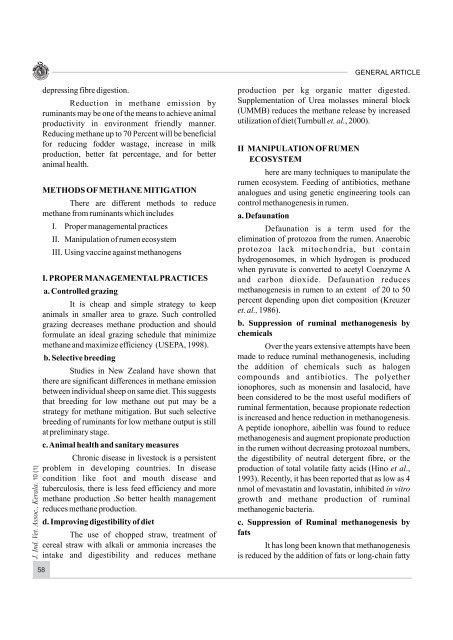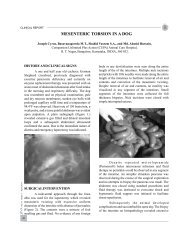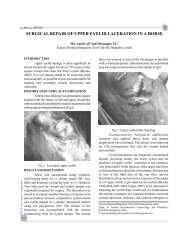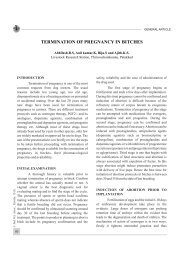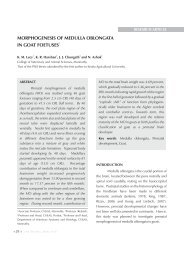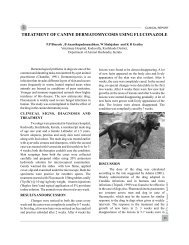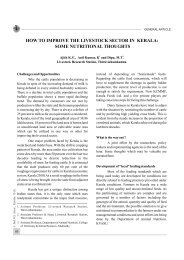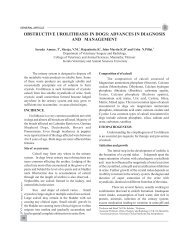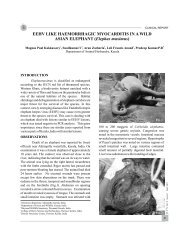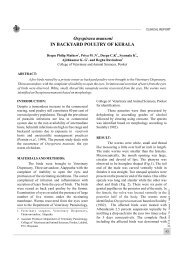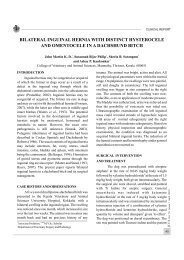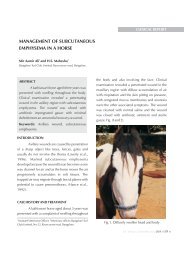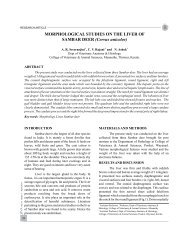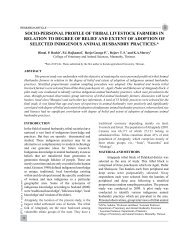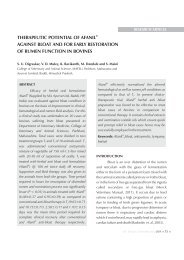2012 Jiva April Cover 220 GSM Art Card Glossy ... - Jivaonline.net
2012 Jiva April Cover 220 GSM Art Card Glossy ... - Jivaonline.net
2012 Jiva April Cover 220 GSM Art Card Glossy ... - Jivaonline.net
You also want an ePaper? Increase the reach of your titles
YUMPU automatically turns print PDFs into web optimized ePapers that Google loves.
GENERAL ARTICLEJ. Ind. Vet. Assoc., Kerala. 10 (1)depressing fibre digestion.Reduction in methane emission byruminants may be one of the means to achieve animalproductivity in environment friendly manner.Reducing methane up to 70 Percent will be beneficialfor reducing fodder wastage, increase in milkproduction, better fat percentage, and for betteranimal health.METHODS OF METHANE MITIGATIONThere are different methods to reducemethane from ruminants which includesI. Proper managemental practicesII. Manipulation of rumen ecosystemIII. Using vaccine against methanogensI. PROPER MANAGEMENTAL PRACTICESa. Controlled grazingIt is cheap and simple strategy to keepanimals in smaller area to graze. Such controlledgrazing decreases methane production and shouldformulate an ideal grazing schedule that minimizemethane and maximize efficiency (USEPA, 1998).b. Selective breedingStudies in New Zealand have shown thatthere are significant differences in methane emissionbetween individual sheep on same diet. This suggeststhat breeding for low methane out put may be astrategy for methane mitigation. But such selectivebreeding of ruminants for low methane output is stillat preliminary stage.c. Animal health and sanitary measuresChronic disease in livestock is a persistentproblem in developing countries. In diseasecondition like foot and mouth disease andtuberculosis, there is less feed efficiency and moremethane production .So better health managementreduces methane production.d. Improving digestibility of dietThe use of chopped straw, treatment ofcereal straw with alkali or ammonia increases theintake and digestibility and reduces methaneproduction per kg organic matter digested.Supplementation of Urea molasses mineral block(UMMB) reduces the methane release by increasedutilization of diet(Turnbull et. al., 2000).II MANIPULATION OF RUMENECOSYSTEMhere are many techniques to manipulate therumen ecosystem. Feeding of antibiotics, methaneanalogues and using ge<strong>net</strong>ic engineering tools cancontrol methanogenesis in rumen.a. DefaunationDefaunation is a term used for theelimination of protozoa from the rumen. Anaerobicprotozoa lack mitochondria, but containhydrogenosomes, in which hydrogen is producedwhen pyruvate is converted to acetyl Coenzyme Aand carbon dioxide. Defaunation reducesmethanogenesis in rumen to an extent of 20 to 50percent depending upon diet composition (Kreuzeret. al., 1986).b. Suppression of ruminal methanogenesis bychemicalsOver the years extensive attempts have beenmade to reduce ruminal methanogenesis, includingthe addition of chemicals such as halogencompounds and antibiotics. The polyetherionophores, such as monensin and lasalocid, havebeen considered to be the most useful modifiers ofruminal fermentation, because propionate redectionis increased and hence reduction in methanogenesis.A peptide ionophore, aibellin was found to reducemethanogenesis and augment propionate productionin the rumen without decreasing protozoal numbers,the digestibility of neutral detergent fibre, or theproduction of total volatile fatty acids (Hino et al.,1993). Recently, it has been reported that as low as 4nmol of mevastatin and lovastatin, inhibited in vitrogrowth and methane production of ruminalmethanogenic bacteria.c. Suppression of Ruminal methanogenesis byfatsIt has long been known that methanogenesisis reduced by the addition of fats or long-chain fatty58


